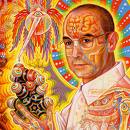Lysergic acid diethylamide (LSD)
History
The psychedelic drug/entheogen LSD was first synthesized by the Swiss chemist Albert Hofmann in the Sandoz (now Novartis) laboratories in Basel, Switzerland in 1938. It was not until five years later on April 19, 1943, that the psychedelic properties were discovered. Widespread therapeutic use of LSD-25 and similar psychedelic drugs began in the 1950s. By 1965, there had appeared in scientific journals more than two thousand papers describing treatment, of thirty to forty thousand patients, with psychedelics (Buckman, 1967). Since then, the literature has continued to grow and now includes book-length works as well as the shorter reports published in journals and anthologies.
Almost all therapists reporting these successes have stated that the incidence of recovery or significant improvement was substantially greater than with other therapies used by them in the past. The treatment typically required much less time and was accordingly less costly for the patient.
Reports on therapeutic use
Types of conditions repeatedly stated to respond favorably to treatment with psychedelics include chronic alcoholism, criminal psychopathy, sexual deviations and neuroses, depressive states, phobias, anxiety neuroses. In addition, psychedelics have been used with autistic children, to make them more responsive and to improve behavior and attitudes; with terminal cancer patients, to ease both the physical pain and the anguish of dying; and with adult schizophrenics, to condense the psychosis temporarily and to help predict its course of development.
Legal status
LSD was put on Schedule 1 of the UN Convention on Psychotropic Substances of 1971. Since then it has been illegal worldwide
Risks
Taking it in dangerous or out of the way places can increase the risk of accidents. Accidents may happen while users are hallucinating.
A sudden shock or fright can send the user into an anxiety or panic attack. If this happens the user should be taken to a quiet place, reassured, told they are safe and that the bad feelings will wear off.
When the effects of LSD have faded, users can feel exhausted, weak and depressed.
Users may experience flashbacks, where parts of a trip are briefly re-lived some time after the event.
LSD can complicate mental health problems such as depression, anxiety and schizophrenia.
Charges from opponents of psychedelic therapy have attributed bias and excessive enthusiasm to workers with the drugs. Certainly, some of the early papers were extravagant, as tends to happen with new therapies. But the time has long passed when psychedelics could be hailed as a panacea; and it should be remarked that the bias of the advocates only rarely approaches that of some “distinguished” critics. Some of these critics seem ideologically and emotionally threatened by psychedelic therapy. This has been especially true of psychiatrists heavily committed to psychoanalysis. Psychedelics emerge at a time when analysis is increasingly under strong attack. Much of the opposition to the drugs is thus understandable, but also unjustifiable.
Finally, psychedelic therapy has been assailed as too dangerous. Very definitely, the evidence does not bear this out; and in fact, when the drugs are administered by those therapists and researchers who are most effective, the “dangers” are negligible. This is borne out by studies involving many thousands of patients and experimental drug subjects.
More information
[ LSD and alcoholism: A clinical study of treatment efficacy
>http://scholar.google.be/scholar?hl=nl&client=firefox-a&rls=org.mozilla:nl:official&hs=JEq&q=author:%22Ludwig%22+intitle:%22LSD+and+alcoholism:+A+clinical+study+of+treatment+efficacy%22+&um=1&ie=UTF-8&oi=scholarr], by AM Ludwig and others,
Therapeutic Applications of LSD and Related Drugs, by Robert E. L. Masters and Jean Houston
More information on the therapeutic use of other psycho-active substances




 Creative Commons Attribution
Creative Commons Attribution